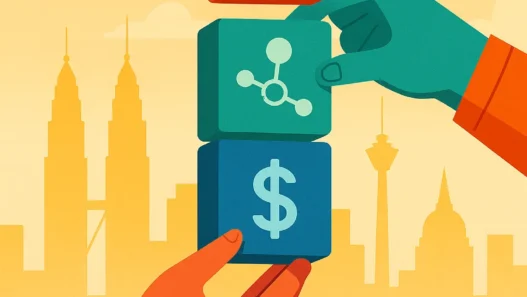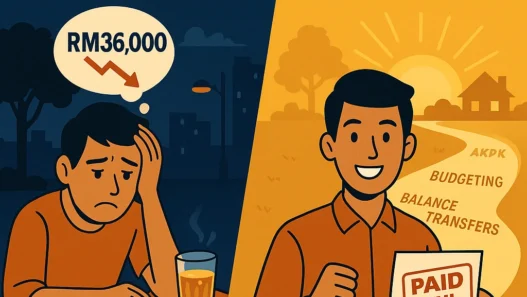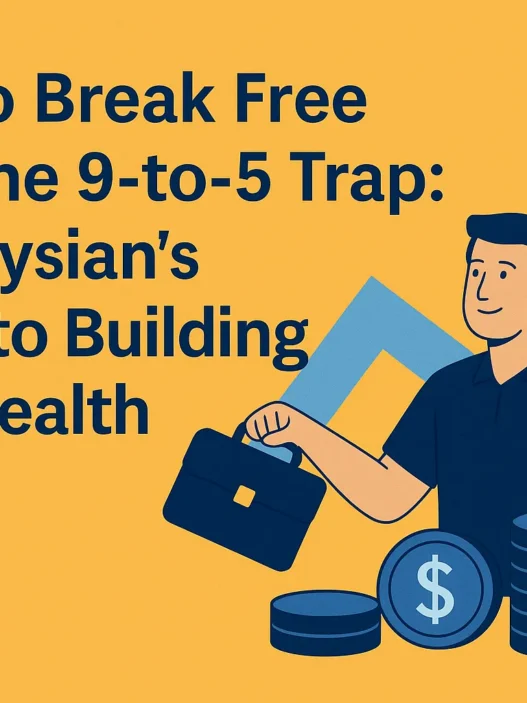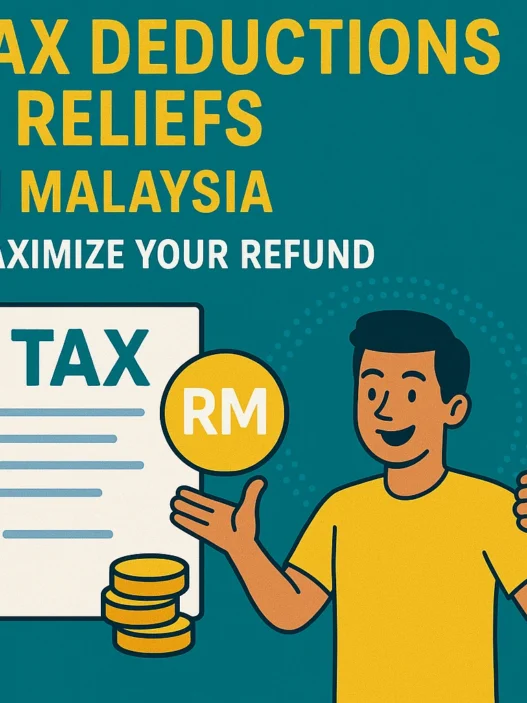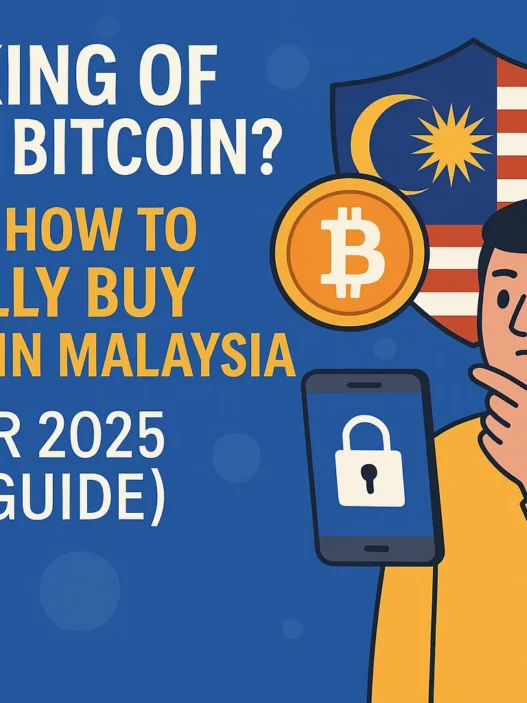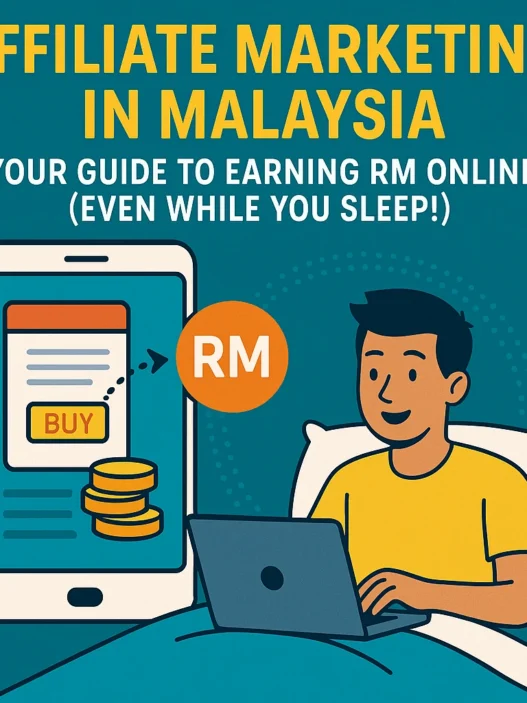Ever feel like your credit card balance is mocking you? That little piece of plastic, once your best friend for that “swipe dulu, fikir kemudian” lifestyle, now feels like a heavy chain? You’re not alone, kawan. Many Malaysians are wrestling with this exact problem, especially with the rising cost of living. It’s like trying to fill a leaking_ teh tarik_ cup – frustrating, right?
But here’s the good news: getting out of credit card debt isn’t some impossible dream reserved for financial gurus. It’s achievable, even for us regular Malaysians! This guide is your practical, no-nonsense companion to understanding and conquering that debt, fast. We’ll break down proven strategies, look at real Malaysian banking options, and even explore how Agensi Kaunseling dan Pengurusan Kredit (AKPK) can be your lifeline. Think of this as your financial GPS, ready to reroute you to a debt-free destination. Jom, kita start!
The Credit Card Debt Trap in Malaysia: Why It’s a Bigger Deal Than You Think
Seriously, that credit card debt can be a silent killer of dreams. One minute you’re enjoying that new gadget or a fancy dinner, and the next, the bills are piling up, and the interest is… wow! Let’s unpack why this is a real concern for us in Malaysia.
Rising Debt Among Youth and Working Adults: It’s Not Just “Young People Problems”
It’s a bit worrying, lah. According to a recent AKPK report, over 53,000 Malaysians under 30 are juggling a massive RM1.9 billion in debt! That’s an average of about RM36,000 per person. Now, consider this: the median monthly income for Malaysians in their 20s hovers around RM2,062. Can you see the red flag waving?
High debt at a young age can really put a damper on big life plans – buying that first home, starting a family, or even just having some savings for a rainy day. It often boils down to easy access to credit cards combined with, let’s be honest, sometimes not enough know-how about managing money. In fact, studies show that only 36% of Malaysians fully grasp basic financial concepts, which is a bit below the global average.
“Credit card debt isn’t just numbers on a statement; it’s the weight of future opportunities being held back.”
Impact on Middle-Income Families: The Everyday Squeeze
And it’s not just the younger generation feeling the pinch. Many hardworking Malaysian adults and middle-income families are in the same boat. Picture this: nearly 28% of Malaysian working adults have had to borrow money just to buy essential goods. That’s a tough pill to swallow.
With wages sometimes feeling stagnant and the cost of, well, everything going up, families are increasingly relying on credit cards for daily expenses. Our nation’s household debt-to-GDP ratio is around 84%, one of the highest in Asia. This means many households are leaning heavily on loans and credit, making them super vulnerable if something unexpected happens, like a job loss or medical emergency. This isn’t sustainable, friends.
Why Credit Card Debt is So Bahaya (Dangerous)!
Here’s the kicker: credit cards in Malaysia typically charge super high interest rates – usually 15% to 18% per annum on your outstanding balance. If you’re only paying the minimum amount each month (that tiny figure they suggest), you’re mostly just paying off the interest, and the actual debt barely shrinks. It’s like trying to run up a down escalator!
For example, a RM5,000 credit card balance can take years to clear and you could end up paying thousands in interest if you only make minimum payments. Ouch! This is exactly why it’s so, so important to pay off credit card debt as fast as humanly possible. Think about it: every ringgit you don’t pay in interest is a ringgit saved for your family’s future, your dreams, or even just a stress-free night’s sleep.
The good news? There are solid strategies and tools available to help you become debt-free faster. You’ve got this!
Wait, Before You Dive In: Two crucial first steps, okay?
- STOP adding new debt. Seriously. Put those credit cards on ice (maybe literally, if it helps!). No more new spending on them while you’re in debt-busting mode.
- Take a hard look at your budget. Where is your money really going? Cut out unnecessary expenses to free up more cash for your debt repayments. Every little bit helps!
These initial steps are the foundation. Get them right, and the strategies below will work wonders.
Your Battle Plan: Snowball vs. Avalanche Method – Mana Satu Sesuai Untuk You?
So, you’ve got multiple debts – maybe a couple of credit cards, a personal loan, that “easy payment plan” for your phone. How do you attack them effectively? Two popular methods can supercharge your progress: the debt snowball and the debt avalanche. Both involve throwing extra cash at one specific debt while paying the minimum on others. The difference is which debt you target first. Let’s break them down, Malaysian style.
The Debt Snowball Method: Small Wins, Big Motivation! (Macam Golek Bola Salji)
Imagine rolling a small snowball down a hill. It starts small, but as it rolls, it picks up more snow and gets bigger and bigger, right? The debt snowball method works on a similar principle. You pay off your debts from the smallest balance to the largest balance, no matter what the interest rate is.
Here’s how:
- List all your debts (credit cards, loans, etc.) from the smallest amount owed to the largest.
- Pay the minimum amount due on all debts except for the one with the smallest balance.
- Throw every extra ringgit you have at that smallest debt until it’s completely GONE!
- Once that first debt is cleared (woohoo!), take the money you were paying on it (minimum + extra) and add it to the minimum payment of the next smallest debt.
- Repeat this process. Each time you pay off a debt, you “snowball” its payment into the next one. Your payment power grows!
- Pros of Snowball:
- Quick Wins: Paying off that first small debt fast feels amazing. It’s a huge psychological boost!
- Motivation King: Those early victories build momentum and make you feel like you can do this. This makes it easier to stick to the plan.
- Simple to Follow: It’s straightforward and great for building good repayment habits.
- Cons of Snowball:
- Potentially More Interest Paid: Because you’re ignoring interest rates, you might pay off a RM1,000 card at 8% interest before a RM5,000 card at 18% interest. This could mean you pay more in total interest over the long run.
- Not Mathematically Optimal: It’s not the absolute cheapest way to get out of debt if we’re crunching pure numbers. It’s a trade-off for that sweet, sweet motivation.
“The Snowball Method: It’s less about the math, more about the ‘Mmm, feels good to win!’ momentum.”
Who should use it? If you find it hard to stay motivated, get easily discouraged, or have a bunch of small, nagging debts, the snowball method could be your champion. Those quick wins can build the discipline you need to tackle the bigger dragons later. It’s perfect if you need clear milestones to keep you fired up!
The Debt Avalanche Method: Settle Hutang Paling Cepat & Jimat Duit! (Macam Runtuhan Salji)
The debt avalanche method is all about logic and saving money. You pay off your debts starting from the highest interest rate to the lowest interest rate, regardless of the balance. Think of it as tackling the most expensive problem first.
Here’s the game plan:
- List all your debts, but this time, order them by their interest rate – highest at the top, lowest at the bottom.
- Pay the minimum amount due on all debts except for the one with the highest interest rate.
- Channel all your extra funds to that highest-interest debt until it’s wiped out.
- Once that’s done, take the total amount you were paying on it and attack the debt with the next highest interest rate.
- Continue until all debts are cleared.
- Pros of Avalanche:
- Saves You the Most Money: This is the most cost-effective way to eliminate debt. By hitting high-interest debt first, you cut down the amount of interest piling up. You’ll pay significantly less in interest charges overall compared to the snowball method.
- Mathematically Fastest (in total interest): Because you’re saving on interest, you are, in a way, getting out of debt “faster” in terms of the total financial burden.
- Great for Big, Nasty Debts: If you have one particularly large balance with a sky-high interest rate (like a maxed-out credit card at 18%), this method tackles it head-on.
- Cons of Avalanche:
- Can Feel Slower: If your highest-interest debt also has a large balance, it might take a long time to pay it off. This can be demoralizing if you don’t see a quick “win.”
- Requires More Discipline: You need to trust the math and stick with it, even when progress feels slow initially.
“The Avalanche Method: Your wallet will thank you later, even if your patience is tested now.”
Who should use it? If you’re driven by logic, motivated by saving money, and have good self-discipline, the avalanche method is probably your best bet. It makes the most financial sense because you’ll pay less interest overall. This is especially good if you have one or two debts with really high interest rates that are costing you a fortune. Just be mentally prepared that the first debt payoff might take a while – but the long-term savings are worth it!
So, Which One is “The Best,” Lah?
Honestly, there’s no single “best” answer that fits everyone. Both the snowball and avalanche methods work because they force you to pay more than the minimum and focus your efforts. The most effective method is the one you can actually stick with consistently.
- Feeling overwhelmed and need those quick wins to keep you going? Go for the Snowball.
- Are you a numbers person who wants to save every possible ringgit on interest? Choose the Avalanche.
You can even get creative and combine them! Maybe start with a small debt to get a snowball win, then switch to avalanche for the bigger, high-interest ones. The key is to make a plan and commit to it. Either way, you’ll be miles ahead of just making those soul-crushing minimum payments.
Up next, let’s explore another powerful tool in your debt-busting arsenal: balance transfer plans from Malaysian banks!
Smart Moves: Using Balance Transfers in Malaysia to Slash Interest
Okay, imagine your credit card debt is a fire, and the high interest rate is the fuel being poured on it. A balance transfer (BT) is like taking away a big chunk of that fuel, or even putting the fire out temporarily so you can deal with the source!
What Exactly is a Balance Transfer, and How Can It Help, Eh?
Simply put, a balance transfer means moving your outstanding credit card debt from one card (usually with a high interest rate) to another credit card. This new card, often from a different bank, will offer you a promotional low interest rate (like 5-8%) or even 0% interest for a limited time (e.g., 6 or 12 months).
This can be a game-changer because:
- It drastically reduces or eliminates interest charges while you focus on paying down the actual amount you owe (the principal).
- More of your monthly payment goes towards reducing your debt, not just feeding the interest beast.
- It essentially buys you time to clear the debt under more favorable terms.
But, and this is a big “tapi,” you must be disciplined to make the most of it. It’s not free money; it’s a tool.
“A balance transfer is like a temporary ceasefire in your war against interest – use that peace wisely to gain ground on your debt.”
In Malaysia, many major banks offer balance transfer plans. Let’s look at what you should consider and then peek at some typical offers. (Disclaimer: These offers are based on information available around early 2024 or as per the context provided. Bank promotions change all the time, so please, please, please always check the bank’s official website or call them for the very latest details and T&Cs before applying! This is general information, not a specific financial recommendation for you.)
What to Look For in a Balance Transfer Plan (Jangan Main Sign Je!):
- Interest Rate / Profit Rate: The magic number! Many plans shout “0% interest!” for a period (e.g., 6 or 12 months). Others offer a low fixed interest (e.g., 5%–8% p.a.) for longer tenures. For Islamic cards, this might be called a “management fee” or profit rate, but it works similarly. The lower, the better, of course!
- Upfront Fee (One-Time Caj): Some 0% interest plans come with a one-time processing fee, usually a percentage of the amount you transfer (e.g., a 3% upfront fee on RM10,000 transferred is RM300). Other plans, especially those with a low interest rate (not 0%), might waive this fee. You need to do the math: sometimes a one-time fee for 0% interest is worth it, especially if you’re sure you can pay off the debt within that 0% period.
- Tenure (Repayment Period): This is how long you get to enjoy that special low or 0% rate. Common tenures are 6, 12, 24, or 36 months. Some banks might even go up to 48 months. Generally, shorter tenures (6-12 months) are more likely to be 0% or have very low rates, while longer tenures might have slightly higher (but still reduced) rates. Crucially, choose a tenure where the monthly payment is something you can comfortably afford, ensuring you can finish paying it off within that promotional period.
- Minimum and Maximum Transfer Amount: Banks usually set a minimum amount you can transfer (e.g., RM1,000). They also cap the maximum, often as a percentage of your new card’s credit limit (e.g., up to 80% or 90%) or a fixed ringgit amount.
- Eligibility: Usually, you need to apply for and get a credit card with the bank offering the balance transfer. Some hot promotions are only for new-to-bank customers (to attract fresh faces), while others are open to existing cardholders. Double-check that you qualify for the specific plan you’re eyeing.
Maybank Balance Transfer Highlights
- 0% for 6 months: With a 1.88% one-time upfront fee (via Maybank2u).
- 0% for 12 months: With a 3% one-time upfront fee (transfer cap may apply, e.g., RM50k).
- Low Interest Instalment Plans:
- 9 months at 9% p.a.
- 12 months at 12% p.a.
- 24 months at 4.5% p.a. (often attractive for longer periods)
- 36 months at 4.95% p.a.
- Key Terms: Min. transfer RM1,000 (RM2,000 for the 36-month plan). Max. transfer up to 90% of your credit limit (or specific promo caps).
- Good for: Those who can clear debt within the 0% tenure, or need a significantly lower rate for longer repayment.
Okay, let’s look at what some major Malaysian banks typically offer, based on the information we have:
Maybank Balance Transfer Highlights
Maybank often has a good mix, with both promotional 0% plans and low-interest options for those who need more time:
- 0% interest for 6 months: Typically comes with a one-time upfront fee of 1.88% on the amount transferred. This is usually an online offer (via Maybank2u) and gives you half a year breathing room from interest.
- Example: Transfer RM6,000. Fee = RM112.80. No interest for 6 months.
- 0% interest for 12 months: Often carries a one-time upfront fee of 3% on the amount. This gives you a full year of 0% interest. (There might be a transfer cap, say around RM50,000 for such promos).
- Think of it this way: You pay 3% of your debt as a fee in exchange for 12 months interest-free. Good deal if you can clear it in a year!
- Low Interest Instalment Plans: If you need longer than a year, Maybank might offer plans with interest instead of upfront fees:
- 9 months at 9% p.a.
- 12 months at 12% p.a.
- 24 months at 4.5% p.a.
- 36 months at 4.95% p.a.
- Notice those 24 and 36-month plans have surprisingly low annual rates! These longer plans usually charge interest but no upfront fee, and 4.5% p.a. is way better than 18% p.a.!
- Key Terms for Maybank (Typical):
- Minimum transfer: RM1,000 for most plans, and RM2,000 for the 36-month plan.
- Maximum transfer: Up to 90% of your available credit limit for most plans, or up to RM50,000 for certain promotions.
Maybank Scenario: You have RM12,000 debt. Option 1: Transfer to Maybank’s 12-month 0% plan. You pay a RM360 fee (3%) upfront, then RM1,000 per month for 12 months (no interest). Total paid: RM12,360. Option 2: The 24-month plan at 4.5% p.a. You’ll pay interest over two years, but it will be significantly less than what your original card charges. Choose based on how quickly you can realistically repay.
CIMB Balance Transfer Highlights
CIMB Bank often keeps things straightforward with low interest rates and frequently no upfront fees on their balance transfers:
- Plan A (Example): 5.99% p.a. for a 6-month tenure (no upfront fee). A solid half-year plan with an interest rate well below standard credit card rates.
- Plan B (Example): 7.99% p.a. for a 12-month tenure (no upfront fee). This gives you one year to repay with an interest rate that’s still much friendlier than the usual 15-18%.
- Key Terms for CIMB (Typical):
- Minimum transfer: RM1,000.
- Maximum transfer: Up to 80% of your CIMB credit card limit.
While CIMB might not always have a flashy 0% interest promo, their low annual rates without an upfront processing fee can be very attractive. A 5.99% p.a. rate for 6 months is roughly like a 3% one-time cost if you compare it to an upfront fee plan. And 7.99% p.a. for 12 months is about 0.67% effective interest per month – still a big saving!
CIMB Scenario: Transfer RM6,000 to CIMB under their 12-month, 7.99% p.a. plan. Your interest for the year would be calculated on a reducing balance (so it’s not a flat RM479.40, but less). This is much better than the RM900-RM1000+ in interest you might pay on a regular card. No upfront fee means your initial cost is zero; just be disciplined with your monthly instalments to clear that RM6,000 within the year.
HSBC Balance Transfer Highlights
HSBC often offers a Balance Transfer Instalment (BTI) program, which can include both 0% options and plans with low monthly rates:
- Plan A (Example): 0% interest for 6 months with a 3% upfront fee. Similar to other banks’ 0% offers – pay that one-time 3% fee and enjoy no interest for half a year.
- Plan B (Example): 0.58% interest per month for 12 months. This monthly rate works out to about 7% per annum. Often, no upfront fee is mentioned for this type of plan; you simply pay the interest each month on the remaining balance.
- Plan C (Example): 0.42% interest per month for 6 months. This is roughly 5% per annum. It seems HSBC sometimes gives an option of paying a small amount of interest monthly instead of a larger upfront fee, even for shorter terms.
- Standard BTI (Example): Alternatively, HSBC’s standard balance transfer instalment plan might be around 7.88% p.a. for flexible tenures of 6, 12, 24, or 36 months. This is similar to CIMB’s approach – a moderate interest rate over a longer period, typically with no upfront fees.
- Key Terms for HSBC (Typical):
- Minimum transfer: RM1,000.
- The exact plans available can depend on whether you’re an existing cardholder or a new applicant. HSBC often has special campaigns for new customers (e.g., longer 0% periods), so it’s always worth checking their latest deals.
Always do the math! If you take HSBC’s 0% 6-month plan with a 3% fee, be absolutely sure you can clear the balance in those 6 months. If you need longer, the 12-month plan at 0.58% per month might be easier on your monthly cash flow, even if it means a bit more in total interest paid compared to a strictly 0% plan (if you could stick to its shorter tenure).
Public Bank Balance Transfer Highlights
Public Bank (PBB) frequently runs balance transfer promotions that are quite popular, often featuring 0% interest with a one-time upfront charge that varies by how long you want the 0% period to last. A typical campaign might look like this:
- 6 months at 0% interest – with a 1% upfront fee (effectively a 1% cost for half a year of 0% financing).
- 12 months at 0% interest – with a 2.5% upfront fee.
- 24 months at 0% interest – with a 4.5% upfront fee.
- 36 months at 0% interest – with a 6.5% upfront fee.
- 48 months at 0% interest – with a 9.5% upfront fee.
For these plans, you pay no ongoing interest during the tenure, only that one-time “upfront interest” (which is the fee). Naturally, the longer you stretch the 0% tenure, the higher the upfront fee – which makes sense, as the bank is giving you a longer period of interest-free borrowing.
- Key Terms for Public Bank (Typical):
- Minimum transfer: RM1,000.
- Maximum transfer: Up to 80% of your available credit limit.
Public Bank Scenario: Let’s say you owe RM10,000. With Public Bank’s 12-month 0% plan, you’d pay an upfront fee of RM250 (2.5%). Then, your monthly payment would be RM833.33 for 12 months (with no interest added). In total, you pay RM10,250 over the year. Compare that to what an 18% interest card would cost you in interest alone on RM10,000 – it’s a huge saving! If you needed 24 months for that same RM10,000, the fee would be RM450 (4.5%), and you’d pay about RM416.67 per month for 24 months. The rule of thumb? Choose the shortest tenure you can genuinely manage to pay off.
The Golden Rule of Balance Transfers: Don’t Fall Back into the Trap!
A balance transfer is a fantastic tool, but only if you use it wisely. Here’s the critical part:
- Commit to paying off (or significantly reducing) the debt within that special promotional period.
- Avoid the trap of making only minimum payments during the 0% period and then BAM! – you’re hit with the standard high interest rate when the promo ends, often on a still-large balance.
- Mark your calendar for when the promotional period ends. Know that date!
- Ideally, calculate your required monthly payment: (Transferred Amount + Upfront Fee) / Number of Months in Promo. Then, set up an automatic transfer for that amount. No excuses!
- And for goodness sake, do NOT rack up new balances on the old card you just cleared, or start spending wildly on the new balance transfer card. You’ll just dig a deeper hole! Some people even snip up their old cards or freeze them to remove temptation (just be mindful of any impact on your overall credit score before outright cancelling many cards at once).
“A balance transfer gives you a ladder out of the debt pit. Don’t use it to just sit more comfortably at the bottom.”
Phew! That’s a lot on balance transfers. Next up, what if things are really tough and these methods still feel out of reach? There’s dedicated help available from AKPK.
When You Need a Lifeline: AKPK’s Debt Management Programme (DMP)
Sometimes, despite our best intentions and efforts, credit card debt (and other debts) can become truly overwhelming. You might feel like you’re drowning, and there’s no way out. If that sounds like you, please know you’re not alone, and there’s professional, confidential, and often free help available.
Enter Agensi Kaunseling dan Pengurusan Kredit (AKPK), which translates to the Credit Counselling and Debt Management Agency. AKPK is an agency set up by Bank Negara Malaysia (our central bank) specifically to help Malaysians who are struggling with their finances. One of their flagship services is the Debt Management Programme (DMP). This isn’t a loan; it’s a structured plan to help you repay your existing debts in a manageable way, with AKPK acting as your guide and negotiator.
What is AKPK and How Can Their DMP Help You? (Macam Mana AKPK Boleh Tolong?)
The DMP is a personalized debt restructuring program. It’s designed to give you a clear, realistic path to becoming debt-free. Here’s how it generally works:
- Counselling & Assessment: When you approach AKPK, they’ll assign a credit counsellor to sit down with you (or talk over the phone) to understand your entire financial situation – your income, expenses, and all your debts.
- Personalized Repayment Plan: Based on this, AKPK will work with you to develop a repayment plan that you can actually afford. This plan takes into account your essential living expenses.
- Negotiation with Banks: AKPK then acts as an intermediary and negotiates with your banks and other creditors on your behalf. This negotiation could involve:
- Restructuring your loans/credit card balances.
- Extending your loan tenures (to make monthly payments smaller).
- Potentially lowering interest rates or even freezing them in some cases.
- Consolidated Payment: If a plan is agreed upon, you’ll often make one single monthly payment to AKPK. AKPK then distributes this payment to all your various creditors according to the agreed plan. This really simplifies things!
The main goals of the DMP are to help you regain control, achieve a reasonable repayment period (often several years, depending on your debt load), and do so without you needing to take on new, potentially predatory loans.
A huge relief for many is that while you’re actively on the DMP and sticking to the payments, creditors will generally halt legal actions and stop those stressful debt collection calls, as long as you adhere to the plan. Imagine the peace of mind!
“AKPK’s DMP is like having a financial personal trainer and a diplomatic negotiator rolled into one, helping you fight your way back to financial health.”
Example: Let’s say Fatimah is juggling three credit cards with high balances, a personal loan, and is struggling to make all the minimum payments. She feels hopeless. If she enrolls in AKPK’s DMP, AKPK might consolidate these into one affordable monthly payment. This payment would be lower than the sum of her current minimums because AKPK might have negotiated longer repayment terms and lower interest rates with her banks. Instead of stressing over multiple due dates, Fatimah makes one payment to AKPK each month, and AKPK handles the rest. She now has a clear path and timeline to clear her debts.
One important thing to note: while you’re in the DMP, you typically cannot obtain new credit (no new loans or credit cards). Your credit report (like CCRIS) will also reflect that you’re under the DMP. This is actually a good thing – it prevents you from accumulating more debt while you’re trying to clear existing ones. Think of it as a financial rehabilitation period.
Am I Eligible for AKPK’s DMP? Jom Check!
The DMP is designed for individuals who are genuinely finding it impossible to manage their debts and need a structured way out. Here are the general eligibility criteria:
- You are not bankrupt. If you’ve already been declared bankrupt, your case falls under the purview of the Malaysian Department of Insolvency, and AKPK usually cannot enroll you. (Seek help before it gets to bankruptcy!)
- You are unable to manage your debts on your own. This means you’re consistently missing payments, having to borrow more just to pay existing bills, or only able to pay the minimums with no end in sight. Basically, you’re in financial distress.
- You have a positive net disposable income. This is crucial. It means that after covering your essential monthly living expenses (food, rent, utilities, transport for work – AKPK will help you budget this), you still have some income left over that can be channeled towards debt repayment. The program requires you to make monthly payments, so you need to have some capacity to pay, even if it’s small.
- You are not under advanced legal action by creditors for your debts. If your debts have already progressed to certain serious legal stages (like a court judgment already issued against you for that specific debt), it might be too late for DMP to intervene on that particular debt. It’s always best to seek help early.
- Your total debt amount does not exceed RM5 million. The DMP is aimed at individuals with consumer debts (like credit cards, personal loans, and sometimes housing and car loans) that fall under this threshold. This covers the vast majority of personal debt situations.
- Your debts are with licensed financial institutions. AKPK can primarily help restructure debts you owe to institutions regulated by Bank Negara Malaysia. This includes most banks, Islamic banks, insurance companies offering credit facilities, and development financial institutions. They cannot help with debts owed to illegal moneylenders (Ah Longs) or other informal/unlicensed lenders. (If you have Ah Long debt, please seek advice from the police or other community support services – that’s a separate, serious issue.)
The good news is that typical unsecured debts like credit card balances and personal loans are very commonly handled under DMP. In fact, credit card debt is the most frequent type of debt seen in DMP cases! In recent years, AKPK has also started including certain hire-purchase (car loans) and housing loans from participating banks in the DMP on a case-by-case basis. If you’re a Malaysian citizen or Permanent Resident with debts you can’t handle, it’s definitely worth contacting AKPK to see if you qualify. Their counselling is free!
How to Apply for AKPK’s DMP: Your Step-by-Step Guide (Senang Je!)
Getting started with AKPK is free of charge and designed to be as straightforward as possible. Here’s a general outline of the process:
- Self-Assessment (Optional but Recommended): Visit the official AKPK website (akpk.org.my). They usually have an online self-assessment tool or an eligibility checker. You’ll answer some basic questions about your debts, income, and financial situation. This can give you an initial idea if DMP might be suitable for you.
- Online Application: If you decide to proceed, you can typically apply for the DMP online through the AKPK portal. You’ll need to fill out an application form, providing details of all your debts (creditor names, account numbers, outstanding balances), your income, your monthly expenses, and other relevant financial information. Be as accurate and honest as possible.
- Gather Your Documents: You’ll need to prepare supporting documents. These usually include:
- Copy of your NRIC (MyKad).
- Latest payslips (e.g., 3 months) or other proof of income (if self-employed).
- Latest EPF statement.
- Recent bank statements.
- Statements for all your debts (credit card statements, loan agreements/schedules, etc.).
- Utility bills (to verify address/expenses). This helps AKPK get a clear picture and verify your financial situation.
- Counselling Session: After you submit your application and documents, AKPK will schedule a counselling session with you. Nowadays, this might be done over the phone, via video call, or in person at an AKPK branch (they have branches in major cities across Malaysia). During this session, a trained credit counsellor will:
- Go through your finances in detail.
- Help you understand your financial situation better.
- Provide advice on budgeting and money management.
- Discuss whether the DMP is the right solution for you.
- Proposal and Negotiation: If the DMP is deemed suitable and you agree, the counsellor will work with you to draft a proposed personalized repayment plan. This plan will outline a single, affordable monthly payment and an estimated timeframe to clear your debts. AKPK will then take this proposal and negotiate with your creditors (the banks) to get their agreement on the restructured terms (e.g., revised interest rates, extended tenures). This negotiation process can take a bit of time (a few weeks, sometimes longer). During this period, it’s usually advisable to continue making at least some payment to your debts if you can, or at least keep your banks informed that you are working with AKPK.
- Enrollment and Repayment Begins: Once all (or most) of your creditors agree to the restructured plan, AKPK will present the final plan to you. If you accept it, you’ll officially be enrolled in the DMP. You will then start making your single, consolidated monthly payment directly to AKPK (they’ll provide clear instructions on how to do this – e.g., via bank transfer, JomPAY, or direct debit). AKPK will then distribute these funds to your various creditors according to the agreed-upon schedule. It is absolutely critical to make these DMP payments on time, every single month. Missing payments could jeopardize the entire arrangement and your creditors might revert to their original terms (or even take action).
- Journey to Debt Freedom & Completion: The DMP continues until all the debts included in your plan are fully paid off according to the restructured terms. This could take several years – the timeline is designed to be realistic and manageable for you. The great thing is, with reduced or frozen interest (as negotiated by AKPK), your payments are actively chipping away at the principal debt. Upon successful completion, you’ll receive a clearance letter from AKPK. You’ll be debt-free from those enrolled debts, and likely much wiser about managing your finances!
How to Get Started with AKPK: You can initiate the process by visiting their website www.akpk.org.my. Look for information on the Debt Management Programme or online registration. Alternatively, if you prefer to speak to someone or need face-to-face assistance, you can call AKPK’s hotline or visit one of their branches. They often have walk-in counselling sessions where they can do an initial assessment and, if DMP is suitable, guide you through the application.
Remember this: AKPK’s counselling services and enrollment into the DMP are completely FREE. You do not need to pay AKPK any fees for this help. Be very wary of any third-party agents or consultants who try to charge you a fee to “help you with AKPK” or “guarantee DMP approval.” You can, and should, deal with AKPK directly.
“Reaching out to AKPK isn’t a sign of failure; it’s a courageous step towards reclaiming your financial future.”
During the DMP: You’ll need to embrace a more disciplined lifestyle and stick to the budget agreed upon with your counsellor. As mentioned, you generally won’t be able to take on new credit, and AKPK may require you to cut up your existing credit cards or close certain accounts as part of the plan (to prevent new debt). Your CCRIS report will indicate your participation in the DMP, which alerts banks. Treat this period as a financial “boot camp” – it’s tough, but it builds strength. Many people find immense relief in just having one manageable payment and a clear end date to their debt nightmare.
Life After the DMP: Once you’ve successfully completed your DMP, you’ll get that wonderful clearance letter. Your credit report will gradually improve over time (especially since the negative records of defaults will stop, and you’ll have a history of consistent repayment via DMP). You can then start rebuilding your financial standing, now armed with much better financial habits and knowledge. In fact, many DMP “graduates” continue to live debt-free and manage their money much more effectively because of the discipline and lessons learned. It’s a far, far better outcome than letting debt spiral into bankruptcy. AKPK also provides ongoing financial education resources if you want to keep learning and growing your money management skills, even after your DMP is completed.
Your Path to Financial Freedom Starts NOW, Kawan!
Phew! We’ve covered a lot, haven’t we? From understanding the credit card debt landscape in Malaysia to practical strategies and how to get serious help when you need it. Let’s quickly recap the key weapons in your arsenal:
- Know Your Enemy: First, truly understand how credit card debt is impacting you and why it’s such a big deal in Malaysia. High interest rates and the ease of “swipe dulu” have caught many, but knowledge is your first step to breaking free.
- Choose Your Battle Strategy: Whether it’s the motivational Snowball method (clearing small debts first for quick wins) or the financially savvy Avalanche method (tackling highest interest debts first to save money), pick one and stick to it. Always aim to pay more than the minimum.
- Use Smart Tools like Balance Transfers: Don’t be afraid to explore balance transfer options from Malaysian banks (like Maybank, CIMB, HSBC, Public Bank, and others). Getting a 0% or low-interest period can drastically cut your interest costs and help you pay down the principal faster. Just remember the golden rule: be disciplined and pay it off within the promo period! (Always check directly with banks for their latest offers and T&Cs).
- Don’t Be Afraid to Ask for Help (AKPK is Your Friend!): If your debt feels like a mountain you can’t climb alone, please reach out to AKPK. Their Debt Management Programme (DMP) has helped tens of thousands of Malaysians restructure their debts, stop the creditor calls, and get back on their feet. Their counselling and DMP enrollment are FREE.
Becoming debt-free is definitely a journey, not a sprint. It takes determination, discipline, and sometimes, making some tough choices. But it is absolutely, 100% doable. Every single ringgit extra you pay towards your debt, every unnecessary expense you cut, every smart move you make (like a balance transfer or seeking AKPK’s help) is a step closer to that incredible feeling of financial freedom.
Thousands of Malaysians – young adults, families, people from all walks of life – have successfully navigated their way out of credit card debt using the very methods we’ve talked about. You can be one of them too.
“The best time to plant a tree was 20 years ago. The second best time is now. The same goes for tackling your debt – start today!”
So, what are you waiting for? Take a deep breath, make a commitment to yourself and your family’s future, and start taking action today. Use the knowledge from this guide, create your plan, and begin chipping away at that debt. Bit by bit, you’ll see those balances shrink, and one day, you’ll make that final payment and breathe the sweet air of debt-free living.
Good luck on your journey! We’re cheering you on.
Want more tips on managing your money, saving, and investing in Malaysia? Explore other articles and resources right here on our portal!
Great, I’ll prepare a detailed and professionally written guide for Malaysian working adults and middle-income families on how to pay off credit card debt quickly. It will include an overview of the snowball vs. avalanche strategies, up-to-date examples of balance transfer plans from Malaysian banks with rates, and information about AKPK’s Debt Management Program for those facing serious financial distress. I’ll let you know as soon as it’s ready.
How to Pay Off Credit Card Debt Fast in Malaysia: A Comprehensive Guide
Credit card debt can spiral out of control if not managed properly. In Malaysia, this issue is increasingly common among young adults and middle-income families. This guide provides a step-by-step approach to tackle credit card debt quickly and effectively. We’ll explore the extent of the problem in Malaysia, compare two popular debt repayment strategies (the snowball vs. avalanche methods), review balance transfer plans offered by major Malaysian banks, and explain how to seek help from Agensi Kaunseling dan Pengurusan Kredit (AKPK)’s Debt Management Programme (DMP). The tone is professional yet friendly – because getting out of debt is serious, but you don’t have to do it alone.
Understanding the Credit Card Debt Issue in Malaysia
Rising Debt Among Youth and Working Adults: Malaysia is facing a worrying rise in consumer debt, especially on credit cards. A recent AKPK report revealed over 53,000 Malaysians under the age of 30 holding a combined RM1.9 billion in debt (averaging about RM36,000 per person). This is alarming given that the median monthly income for Malaysians in their 20s is only around RM2,062. High debt at a young age can delay life goals like buying a home or starting a family, and it often stems from easy access to credit combined with low financial literacy. In fact, only 36% of Malaysians understand basic financial concepts, below the global average.
Impact on Middle-Income Families: It’s not just the youth. Many working adults and middle-income families are also struggling with debt. Nearly 28% of Malaysian working adults have had to borrow money just to purchase essential goods. Stagnant wages and a high cost of living have forced families to rely on credit cards for daily expenses. Malaysia’s household debt-to-GDP ratio stands around 84%, one of the highest in the region. This means households (including middle-income families) are heavily reliant on loans and credit to sustain their lifestyle, making them vulnerable to financial stress. If not carefully managed, such debt can lead to long-term strain.
Why Credit Card Debt is Dangerous: Credit cards typically charge high interest rates – usually 15%–18% per annum on outstanding balances. If you only pay the minimum each month, interest charges will accumulate rapidly. For example, a RM5,000 credit card balance can take years to clear and rack up thousands in interest if you pay just the minimum. This is why it’s crucial to pay off credit card debt as fast as possible. Every ringgit in interest you avoid paying is a ringgit saved for your family’s future. The good news is there are proven strategies and tools to help you become debt-free faster.
Before you begin: Make sure to stop adding new debt – put your credit cards aside to avoid further spending. Also, review your budget to cut unnecessary expenses and free up cash for debt repayment. These initial steps will set the foundation for the strategies below to work effectively.
Debt Repayment Strategies: Snowball vs. Avalanche
When it comes to paying off multiple debts (e.g. several credit cards or loans), two popular methods can accelerate your progress: the debt snowball and the debt avalanche. Both methods involve focusing extra money on one target debt while paying minimums on the rest, but they differ in how you choose which debt to target first. Let’s break down each method and discuss their pros and cons.
The Debt Snowball Method
The snowball method means paying off your debts from smallest balance to largest balance, regardless of interest rate. You list all your credit card debts and other debts by amount owed, pay the minimum on all but the smallest, and throw any extra money at the smallest debt first. Once that smallest debt is paid in full, you “snowball” its payment into the next smallest debt, and so on. Over time, the payment amount you can put toward each remaining debt grows larger – like a snowball rolling and growing.
- Pros of Snowball: Quick wins can be very motivating. By clearing a small debt quickly, you get a psychological boost and a sense of accomplishment. This momentum can encourage you to keep going. The method is simple and great for building good repayment habits. Many people find it easier to stick with because the progress is visible early on.
- Cons of Snowball: It may cost more in interest overall. Because you ignore interest rates, you might pay off a low-balance card with 5% interest before a high-balance card with 18% interest. This means you could end up paying extra interest in the long run compared to a strategy that prioritizes interest rates. In short, it’s not the mathematically cheapest way to eliminate debt – it’s a trade-off for the sake of motivation.
Who should use it? If you struggle with staying motivated or have many small debts, the snowball method might be right for you. The confidence boost from those early victories can build the discipline needed to tackle bigger debts. It’s an ideal strategy for individuals who need clear milestones and encouragement to remain committed.
The Debt Avalanche Method
The avalanche method takes the opposite approach: pay off your debts from highest interest rate to lowest interest rate, regardless of balance. First, list your debts by interest rate. You focus extra payments on the debt with the highest interest (while paying minimums on the others). Once the highest-rate debt is cleared, you move to the next highest rate, and so on.
- Pros of Avalanche: It is the most cost-effective and fastest way (in terms of total interest paid) to eliminate debt. By attacking high-interest debt first, you minimize the amount of interest accumulating. Over time, you will pay significantly less in interest charges compared to the snowball method. For mathematically minded people, it’s satisfying to know you’re saving money. If you have a large balance at a high interest (like a big credit card debt at 18%), this method addresses it head-on.
- Cons of Avalanche: The biggest debt might take a long time to fully pay off, which can be demoralizing. Because you start with the highest interest rate (often a large balance), you won’t see debts eliminated as quickly. Some people lose steam if they don’t get a “win” early on. It requires discipline to stick with a plan when progress feels slower. In short, it’s efficient but can feel slower from a motivational perspective.
Who should use it? If you are highly disciplined or motivated by saving money, the avalanche method is a great choice. It makes the most financial sense because you’ll pay less interest overall and potentially get out of debt faster (time-wise) than with the snowball, assuming you stick to the plan. Those with one particularly large, high-interest debt (like a maxed-out credit card) may benefit from tackling it first. Just be mentally prepared that the first debt payoff might take longer – but you will reap the rewards in interest savings.
Which Strategy is Better?
There is no one-size-fits-all answer. Both methods require you to pay as much as possible towards one target debt while maintaining minimums on others, and both will eventually clear all debts. The best method is the one you can commit to consistently. If small victories keep you going, choose the snowball. If saving every ringgit in interest is your priority, choose the avalanche. The key is to start and stay focused – either approach will dramatically improve your situation compared to making only minimum payments.
Tip: You can combine strategies too. For example, you might use the avalanche method but break a large debt into milestones to mimic the motivational boosts of the snowball. The important thing is to make a plan and stick to it. In the next section, we’ll look at another tool to accelerate debt repayment: balance transfer offers from Malaysian banks.
Using Balance Transfer Plans to Pay Off Debt Faster
When facing hefty credit card balances, a balance transfer can be a lifesaver. A balance transfer means moving your outstanding credit card debt to another credit card (usually with another bank) that offers a promotional low interest rate or even 0% interest for a limited period. This can significantly reduce or eliminate interest charges while you focus on paying down the principal amount. Essentially, it buys you time to clear the debt without the interest meter running – but you must be disciplined to take full advantage of it.
In Malaysia, many major banks offer balance transfer (BT) plans to help customers consolidate and repay credit card debt. Below is an overview of current balance transfer plans from four major banks – Maybank, CIMB, HSBC, and Public Bank – including their interest rates, promotional tenures, and fees. Using these plans wisely can speed up your debt payoff, as more of your payment goes towards the principal instead of interest. (Always read the fine print and be aware of any fees.)
What to Look for in a Balance Transfer Plan
- Interest Rate / Profit Rate: Many plans offer 0% interest for a certain period (e.g. 6 or 12 months). Others charge a low fixed interest (e.g. 5%–8% per annum) for longer tenures. Islamic cards may quote a “management fee” or profit rate, which works similarly to interest. The lower, the better.
- Upfront Fee: Some 0% interest plans charge a one-time processing fee (usually a percentage of the amount transferred). For example, a 3% upfront fee on RM10,000 is RM300. Other plans with a low interest rate might waive upfront fees. Compare the total cost: sometimes a one-time fee for 0% can be worth it, but you need to be sure you can pay off within the promo period.
- Tenure (Repayment Period): This is the duration you have to pay off the transferred amount under the special rate. Common tenures are 6, 12, 24, or 36 months (some banks even offer up to 48 months). Shorter tenures usually come with 0% or very low rates; longer tenures might have slightly higher rates. Choose a tenure with a monthly payment you can comfortably afford so that you finish paying within that period.
- Minimum and Maximum Transfer Amount: Banks often set a minimum transfer (e.g. RM1,000). They may also cap the amount you can transfer, often as a percentage of your credit limit (e.g. up to 80% or 90% of your available credit line) or a fixed ringgit cap.
- Eligibility: Generally, you must have a credit card with the bank offering the balance transfer. Some promotions are only for new cardholders (to attract new customers), while others are open to all existing cardholders. Ensure you qualify for the specific plan.
Below, we compare key features of balance transfer plans from Maybank, CIMB, HSBC, and Public Bank:
Maybank Balance Transfer Plans
Maybank offers both promotional 0% plans and low-interest plans for longer tenures:
- 0% interest for 6 months – One-time upfront fee of 1.88% on the amount transferred. This is a short-term plan via Maybank2u (online) that lets you avoid interest for half a year. For example, transferring RM6,000 would incur a RM112.80 fee, but no interest for 6 months.
- 0% interest for 12 months – One-time upfront fee of 3% on the amount. This gives you a year of no interest. (There may be a cap around RM50k transfer for this promo.) Essentially, you’re paying 3% of the debt as a fee, in exchange for 12 months interest-free – a good deal if you can clear the balance in a year.
- Low interest instalment plans: If you need longer to repay, Maybank has options with interest instead of upfront fees: 9 months at 9% p.a., 12 months at 12% p.a., 24 months at 4.5% p.a., or 36 months at 4.95% p.a.. Notice that the 24- and 36-month plans have much lower annual rates – likely a promotional rate calculated differently (they may be on a reducing balance basis). These longer plans charge interest but no upfront fee. For example, 24 months at 4.5% per annum is quite low compared to the normal 15–18% card rate.
Maybank Example: If you have RM12,000 debt, you could transfer to Maybank and choose 12 months 0% with 3% fee – you pay RM360 fee upfront and RM1,000 per month for 12 months (no interest). Alternatively, the 24-month plan at 4.5% p.a. means you pay interest over two years, but it’s significantly less interest than a normal card would charge. Choose based on your repayment ability.
(Min. transfer for Maybank plans: RM1,000 for most plans, and RM2,000 for the 36-month plan. Maximum transfer is up to 90% of your available credit limit for most plans, or RM50,000 for certain promos.)
CIMB Balance Transfer Plans
CIMB Bank keeps it straightforward with low interest rates and no upfront fees on their balance transfer:
- Plan A: 5.99% p.a. for 6 months (no upfront fee). This is a half-year plan with a flat interest rate well below normal credit card rates.
- Plan B: 7.99% p.a. for 12 months (no upfront fee). One year to pay off with interest far lower than the typical 15-18%.
Both plans require a minimum transfer of RM1,000, and you can transfer up to 80% of your CIMB credit card limit. While CIMB doesn’t currently advertise a 0% interest promo, their low annual rates without any processing fee can be attractive. Essentially, 5.99% p.a. for 6 months is roughly equivalent to a one-time 3% cost (if you were to compare to an upfront fee), and 7.99% p.a. for 12 months is about the same as a 0.67% per month interest – still much cheaper than regular cards.
CIMB Example: Transfer RM6,000 to CIMB under Plan B (7.99% for 12 months). Your interest for the year would be around RM six hundred plus (roughly – actual will be on reducing balance), versus potentially over RM1,000 on a normal card. No upfront fee means your initial cost is zero; just be disciplined to pay the monthly instalment that clears the RM6,000 in a year.
HSBC Balance Transfer Plans
HSBC offers a Balance Transfer Instalment (BTI) program with both 0% option and low monthly rates:
- Plan A: 0% interest for 6 months with a 3% upfront fee. This works like other banks’ 0% offers – pay a one-time 3% fee and enjoy no interest for 6 months.
- Plan B: 0.58% interest per month for 12 months. This monthly interest equates to about 7% per annum. No upfront fee is mentioned for this plan; you simply pay interest each month on the remaining balance.
- Plan C: 0.42% interest per month for 6 months. This is roughly 5% per annum. It appears HSBC gives an option of paying some interest monthly instead of an upfront fee, even for a short 6-month term (perhaps to appeal to those who prefer spreading out the cost).
- Standard BTI: Alternatively, HSBC’s standard balance transfer instalment plan is 7.88% p.a. for flexible tenures of 6, 12, 24, or 36 months. This is similar to CIMB’s approach – a moderate interest rate over up to 3 years, and typically no upfront fees.
Minimum transfer for HSBC is RM1,000. The exact plans available might depend on whether you’re an existing cardholder or new applicant. HSBC often has specific campaigns for new customers (e.g. 0% for X months) so it’s worth checking their latest offers. Always calculate whether you can pay off within the promo period. For instance, if you take the 0% 6-month plan with 3% fee, be sure you can clear the balance in 6 months. If you need longer, the 12-month 0.58% per month plan might be easier on your cash flow (though slightly more in interest).
Public Bank Balance Transfer Plans
Public Bank (PBB) frequently runs balance transfer promotions with 0% interest and a one-time upfront charge that varies by tenure. As of a recent campaign, Public Bank offered the following for its credit card holders:
- 6 months at 0% – 1% upfront fee (effectively 1% cost for half-year financing).
- 12 months at 0% – 2.5% upfront fee.
- 24 months at 0% – 4.5% upfront fee.
- 36 months at 0% – 6.5% upfront fee.
- 48 months at 0% – 9.5% upfront fee.
Each of these plans charges no interest during the tenure, only the one-time “upfront interest” (fee) as listed. The longer you stretch the tenure, the higher the fee – which makes sense as you’re getting a longer period of zero interest. The minimum transfer is RM1,000 and you can transfer up to 80% of your available credit limit.
Public Bank Example: Suppose you owe RM10,000. With Public Bank’s 12-month plan, you’d pay an upfront fee of RM250 (2.5%) and then RM833.33 per month for 12 months (no interest). In total, you pay RM10,250 over the year, which is much less than what a 18% interest card would cost in interest alone. If you need 24 months for the same RM10k, the fee would be RM450, and you’d pay about RM416.67 per month for 24 months. Choose the shortest tenure you can manage comfortably.
(Note: Balance transfer promotions can change frequently. The above figures were valid for a campaign period in early 2024. Banks may extend or introduce new promos – always check the latest details on the bank’s website or call their customer service. Also ensure you make payments on time; if you default on a balance transfer plan, the 0% or low rate may be revoked and you could be charged normal interest or penalties.)
Using a Balance Transfer Wisely: A balance transfer is a powerful tool only if you commit to paying off (or substantially down) the debt within the special rate period. Avoid the trap of making only minimum payments during the 0% period and then ending up back at a high interest rate afterward. Mark your calendar for when the promo period ends. Ideally, divide the transferred amount by the number of months in the plan to get your required monthly payment for debt freedom, and set up an automatic transfer for that amount. And crucially – do not rack up new balances on the old card you just cleared, or you’ll double your debt! Some people even cancel or freeze their paid-off cards to remove temptation (just be mindful of any impact on your credit score before canceling cards).
Getting Help: AKPK’s Debt Management Programme (DMP)
If your credit card debt (and other debts) have become unmanageable despite your best efforts, you’re not alone – and there’s help available. Agensi Kaunseling dan Pengurusan Kredit (AKPK), or the Credit Counselling and Debt Management Agency, is an agency set up by Bank Negara Malaysia (the central bank) to assist Malaysians with financial difficulties. One of AKPK’s key offerings is the Debt Management Programme (DMP), which is essentially a structured plan to repay your debts with guidance and negotiation by AKPK. This section explains how AKPK’s DMP works, who qualifies, and how to apply.
What is the AKPK Debt Management Programme?
The DMP is a personalized debt restructuring program. When you enroll in DMP, AKPK will assign a credit counselor to review your finances and debts. They will work with you to develop a personalized repayment plan that fits your budget. AKPK then acts on your behalf to negotiate with your banks and creditors. This could involve restructuring your loans or credit card balances – for example, extending loan tenures and potentially lowering interest rates to reduce your monthly burden. Multiple debts can be consolidated into a single monthly payment that you make to AKPK, and AKPK will distribute the payment to all your creditors accordingly.
In essence, the DMP gives you a feasible roadmap to become debt-free over a longer term (typically several years, depending on your situation), without needing to take on new loans. Importantly, while you are on the DMP, creditors will halt legal actions and debt collection harassment, as long as you stick to the agreed payment plan. Interest on credit cards and loans may be reduced or even frozen in some cases, so that your payments go primarily towards clearing the principal debt. The program aims to achieve a reasonable repayment period given your financial situation, rather than leaving you drowning in interest and late fees.
Example: If you have multiple credit cards, personal loans, etc. that you can’t keep up with, AKPK might consolidate these into one monthly payment that is lower than the sum of your current payments (by extending time and lowering rates). Instead of juggling five different due dates, you pay AKPK one amount every month. This simplifies your finances and ensures your essential living expenses are covered first. Over time, you pay down all the debts under AKPK’s arrangement.
A big relief for many is that enrolling in DMP means you won’t be chased by collectors – it provides peace of mind so you can focus on recovery. However, note that while in the program, you typically cannot obtain new credit. Participants are generally barred from taking on new loans or credit cards until they exit the DMP. This is actually a good thing, since taking new loans while on a debt programme would be counterproductive. Just be aware it will temporarily affect your access to credit and might be noted in your credit report (it’s better than a bankruptcy record, though!).
Who Qualifies for AKPK’s DMP?
The DMP is meant for individuals who genuinely cannot manage their debts and need a structured solution. AKPK has basic eligibility criteria to ensure the programme is used by those in need. You are generally eligible if:
- You are not bankrupt. (If you have already been declared bankrupt, your case falls under the Malaysian Insolvency Department, and AKPK cannot enroll you.)
- You are unable to manage your debts on your own. This typically means you’re constantly missing payments, need to borrow more to pay bills, or only able to pay minimums with no end in sight – basically, you’re in financial distress.
- You have a positive net income. In other words, after your essential expenses, you still have some income left that can go toward debt repayment. The program requires you to make monthly payments – so you need some repayment capacity. AKPK will help budget your essentials to carve this out.
- You are not under advanced legal action by creditors. If your debts have already progressed to certain legal stages (e.g. a court judgment), you might need to resolve that first. Typically, if you seek help early, this isn’t an issue.
- Your total debt does not exceed RM5 million. The DMP is aimed at individuals with personal debts (credit cards, personal loans, housing and car loans, etc.) under this threshold. RM5 million covers the vast majority of personal debt cases (if you owe more than that, you might need more specialized restructuring or are likely a large borrower).
- Debts with licensed financial institutions. AKPK can only restructure loans from institutions under Bank Negara Malaysia’s purview – basically banks, Islamic banks, insurance companies, development financial institutions, etc. This includes credit card issuers and formal lenders. They cannot help with illegal loan sharks or Ah Longs. (If you have such debts, you should seek other avenues like police or community advice, but that’s outside AKPK’s scope.)
The good news is that most typical unsecured debts are covered. Credit card debts are actually the most common debt type in DMP (nearly half of DMP cases involve credit card balances). Personal loans, home loans, and car loans can also be included. AKPK previously didn’t handle hire-purchase (car) or student loans, but in recent years they have started including certain banks’ car and housing loans in the programme on a case-by-case basis. Essentially, if you’re a Malaysian (or PR) with debts you can’t handle, it’s worth contacting AKPK to see if you qualify.
How to Apply and What to Expect
Applying for DMP is free and relatively straightforward. Here’s how you can get started:
- Self-Assessment: Visit the official AKPK website and use their online self-assessment tool (usually on the homepage, labeled something like “DMP Eligibility Test”). You’ll answer some questions about your debts, income, and situation. This helps determine if DMP might be suitable for you. If the results indicate you’re eligible, you’ll be prompted to proceed with an application.
- Online Application: You can apply for the DMP online by filling out the application form via the AKPK portal. You’ll need to provide details of all your debts (amounts, account numbers, banks), your income, monthly expenses, and so on. Accuracy is important. Once completed, print out the form.
- Submit Documents: Along with the form, you’ll have to submit supporting documents – typically copies of your NRIC, latest payslips or income proof, bank statements, EPF statement, bills, and statements for each debt (credit card statements, loan schedules). These help AKPK verify your financial situation.
- Interview/Counseling: After receiving your application, AKPK will schedule a consultation (nowadays this might be done over the phone or in person at an AKPK branch). A counselor will go through your finances to understand the issue fully. They will also advise you on budgeting and financial management as part of the service.
- Proposal & Negotiation: The counselor will draft a proposed repayment plan. For example, they might propose you pay RMX per month for Y years to settle all debts. They negotiate with your creditors (the banks) to get agreement on this plan – including possibly lowering interest rates or waiving late fees to make the plan viable. This negotiation can take a bit of time (a few weeks perhaps). During this period, you should continue paying something to your debts if you can, or at least inform your banks that you’re working with AKPK.
- Enrollment & Repayment: Once a plan is agreed, AKPK will present it to you. If you accept, you’ll officially enroll in the DMP. You will make a single monthly payment to AKPK (either via bank transfer, Direct Debit, or other methods). AKPK will then distribute the funds to your various creditors as per the plan. It’s critical to pay on time every month. Missing DMP payments could jeopardize the arrangement.
- Completion: The program continues until all the included debts are paid off under the restructured terms. This could take several years – the timeline is designed to be “reasonable,” meaning something you can afford each month. There is no interest (or reduced interest) accumulating beyond what’s agreed, so you’re steadily chipping away at the balances. Upon completion, you’ll be debt-free and likely wiser for the experience.
How to get started: You can initiate the process entirely online as described. Alternatively, if you prefer face-to-face help, you can call AKPK’s hotline or visit one of their branches (located in major cities) to set up a counseling appointment. AKPK also hosts walk-in debt counseling at branches – they’ll do an assessment and if DMP is right for you, guide you through the application. The counseling and advice are free; AKPK does not charge fees for enrolling in the DMP. Beware of any third parties or consultants asking for payment to “help you with AKPK” – you do not need to pay anyone to access AKPK’s services.
During the DMP: You will need to adjust your lifestyle to live within the budget agreed upon. AKPK may require you to cut up your credit cards or close accounts as part of the plan (so you don’t incur new debt). You also won’t be able to get new loans or cards while on the programme, and your CCRIS (Central Credit Reference Information System) report will indicate you’re under AKPK DMP, which alerts banks not to extend new credit. Treat this period as a rehabilitation phase for your finances. Many people find relief in being able to focus on a single payment and knowing there’s an end date to their debt.
After the DMP: Upon successfully completing your DMP, you’ll receive a clearance letter. Your credit report will improve over time, and you can gradually rebuild your financial standing – now armed with better financial habits. In fact, going through the DMP often teaches discipline and budgeting, and many graduates of the program continue to live debt-free thereafter. It’s a far better outcome than allowing debt to snowball to the point of bankruptcy. AKPK also provides financial education resources if you want to learn more about managing money, even after your DMP is over.
In Summary: Paying off credit card debt fast requires a mix of smart strategy and the right tools. As a recap:
- Understand the problem: Recognize how credit card debt is affecting you and learn from the broader Malaysian context – high interest and easy credit have trapped many, but you can break free by taking action.
- Use a strategy: Adopt either the snowball or avalanche method (or a combination) to systematically tackle your debts. Make a plan and stick to it, always paying more than the minimum whenever possible.
- Leverage balance transfers: Consider moving your balances to a card with 0% or low interest promotions to save on interest and speed up repayment. We compared Maybank, CIMB, HSBC, and Public Bank plans – these can drastically cut interest costs if used properly. Just be disciplined with the payment schedule.
- Get help if needed: If your debt is overwhelming or you see no way out, don’t hesitate to seek help from AKPK. Their DMP has helped tens of thousands of Malaysians restructure debt and regain financial stability. It’s free, confidential, and meant to give you a second chance without resorting to bankruptcy.
Becoming debt-free is indeed challenging, but it’s absolutely doable with determination and the right approach. Each step you take – cutting down expenses, making an extra payment, transferring a balance, or getting professional help – is bringing you closer to financial freedom. Thousands of Malaysian working adults and families have successfully paid off their credit card debts using the methods above. You can be one of them.
Remember: the sooner you start, the sooner you’ll see results. Make a commitment to yourself and your family’s future. With discipline and the guidance from this guide, you’ll reduce that debt bit by bit, and before you know it, you’ll breathe a sigh of relief as the balances hit zero. Good luck on your journey to a debt-free life!



